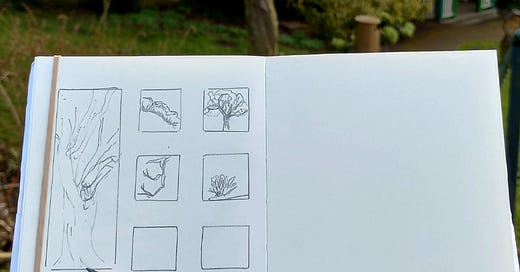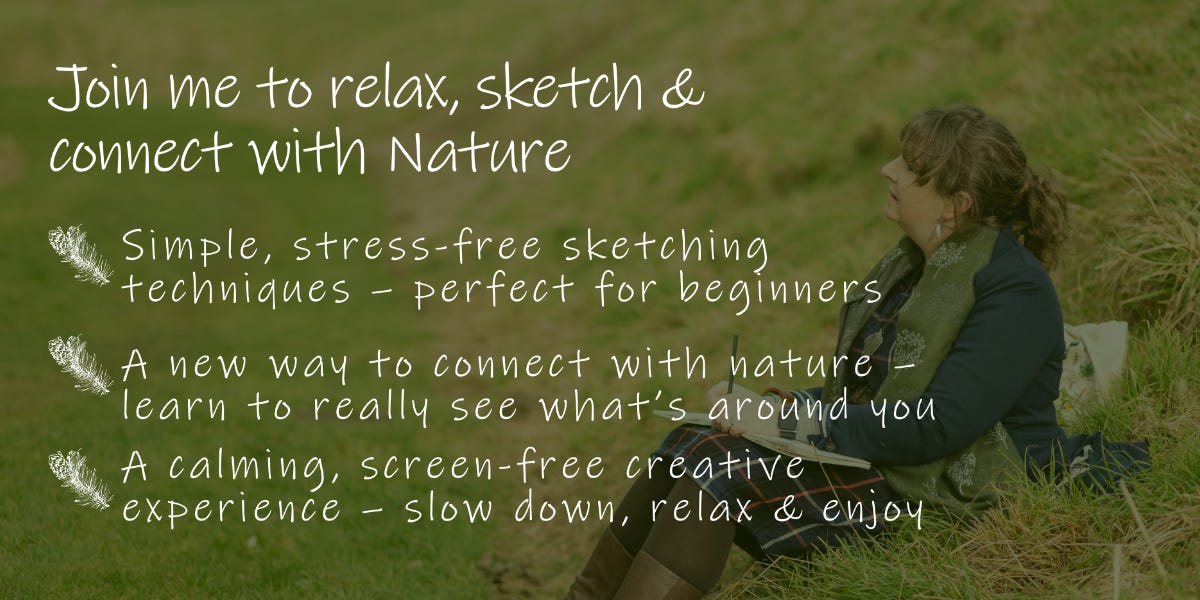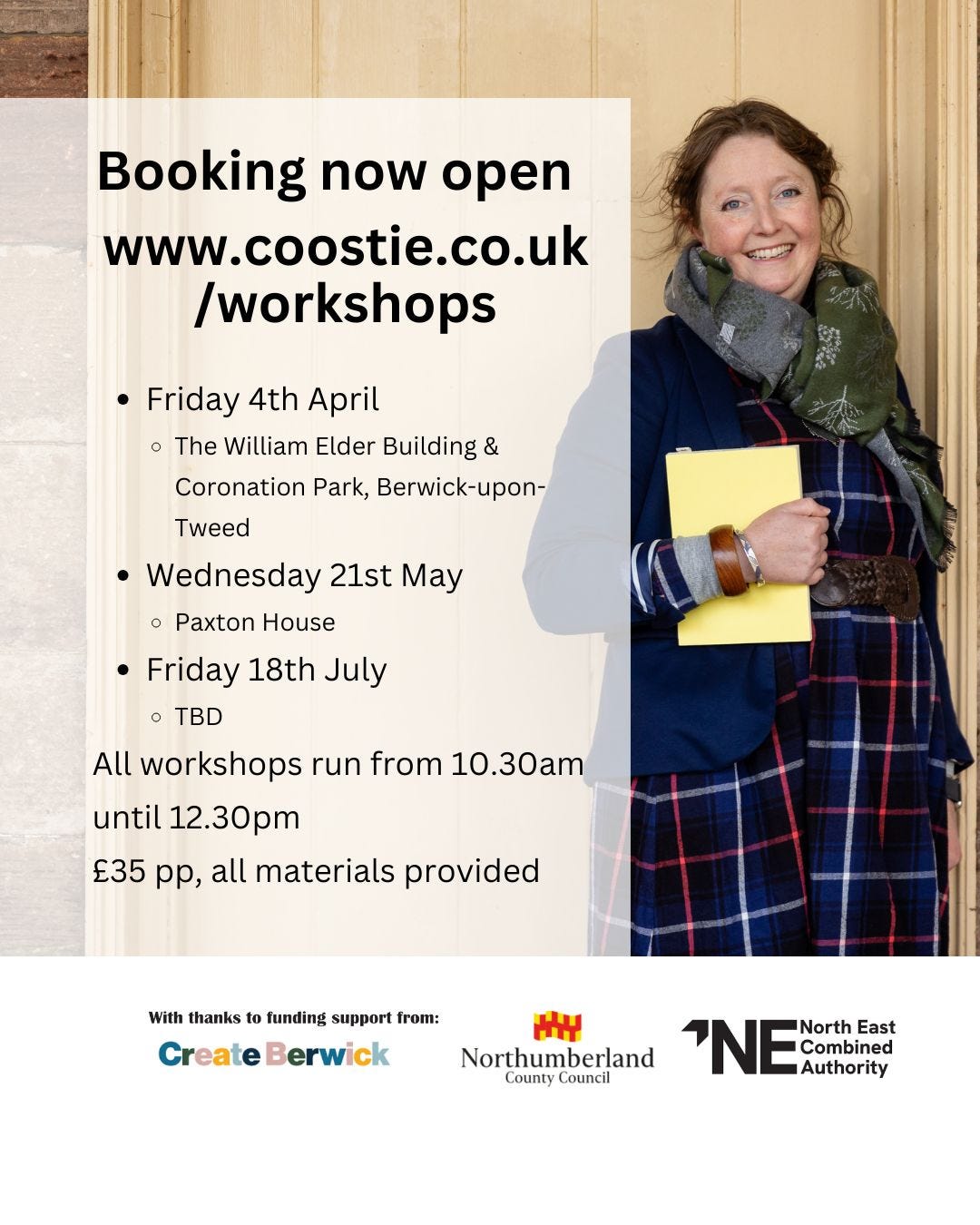An Introduction to Green Sketching
Ditching the screens and getting outside to draw has so many benefits - it would be rude not to!
Have you heard of Green Sketching? Basically, it is a simple, stress-free way to connect with nature through observational drawing. It’s not about creating perfect art - it’s about slowing down, noticing details, and enjoying the process whilst encouraging the powers of observation, curiosity, and mindfulness that we all have inside us somewhere.
As a self-taught artist, I regularly go through periods of self-doubt and frustration in relation to my work. Add to this years of internalised perfectionism and mental attitudes around the ‘right way’ to do things and it is amazing that I ever considered becoming an artist at all - never mind being able to share my work, or consider it of a ‘value’ that people should pay me for it!
I’ve written before about how I came across the concept of Green Sketching:
I started to recover a sense of perspective in relation to my artistic abilities about a year ago, when I got myself a copy of The Green Sketching Handbook by Dr Ali Foxon - a self-proclaimed field guide for helping people relax whilst rediscovering the joy of being in nature.
The book emphasises the therapeutic benefits of Green Sketching, such as enhanced mindfulness, improved well-being, and a deeper connection to the environment. It’s filled with easy-to-follow exercises and insights into nature connection, creativity, and relaxation and really encourages you to let go of self-criticism and find joy in what she terms ‘doodling’.
Last year I got to (virtually) meet Ali when I took her Green Sketching Ambassador training in order to be able to support others to develop the habit. I know that they say ‘never meet your heroes’, but honestly - we had such a great rapport (even over zoom!) and so many experiences and mindsets in common that it was like making a brand new friend, but one who somehow already completely ‘gets’ you. I love it when this happens to me as an adult!
Like Ali, I’ve always been a nature-lover. For me, that has always encompassed more passive things like bird-watching, walking and hiking as well as the more active end of the scale, such as supporting environmental charities and trying to live more sustainably - as well as a decades-long love affair with growing, preserving and eating my own fruit and vegetables. But now my enjoyment of nature also encompasses drawing and painting the things I notice there. I love capturing British wildlife in all its forms and increasingly these birds, animals and plants have come to dominate my artistic output. So why do I feel the need to add ‘Green Sketching’ to my practice and to encourage others to take it up for themselves?

Nature contact vs nature connection
To answer that, I’m going to need to get depressing for a minute!
The UK is one of the most nature-depleted countries in Europe. This is according to the world-leading State of Nature study, which was first commissioned in 2013 (but builds on data gathered over 50 years). One in six of our species are at risk of extinction and the UK has lost more than half of its biodiversity due to human activity. Whilst it has taken centuries to reach this tipping point, reach it we have with biodiversity loss now clearly accelerating. If you are middle-aged, as I am, you'll know the feeling that there used to be more wildlife when you were a child roaming in the countryside, or even just playing in your back garden, than it feels like there is today.
Unfortunately it seems as though the more we lose, the less we care or even notice - even though living in a nature-depleted country has proven negative consequences for our physical and mental health, as well as the direct costs associated with lost or damaged ecosystems to UK agriculture, food production, house building, insurance, the list goes on.
Halting and reversing the decline will obviously take governmental intervention and systemic change - but we can all contribute to this movement in small ways by doing more to notice, appreciate and then defend the natural landscape and wildlife on our doorsteps.
Enter Green Sketching
Part of the problem - even for people who consider themselves ‘outdoorsy’ - is that we can walk/cycle/run in nature without paying attention to it; and we can hear a bird without consciously listening to it. The practice of Green Sketching helps us to go beyond 'being in' nature (although this is definitely better than never stepping outside at all) and to begin to feel (re)connected to it. Slowing down, observing closely and recording what we notice through the physical act of sketching begins a process of active engagement, strengthening our connection with the natural world and making us more keen to look after it. As an added bonus, strengthening our connection with nature also delivers us more personal benefits for our mental health and wellbeing. In short, engaging actively with nature makes us happier, calmer and generally healthier as well as making it easier for us to take decisions in our daily lives that will benefit nature (whether that is ditching the car for public transport, or investing in solar panels for our rooves).
Green Sketching encourages us to see nature differently - taking the time to notice details we’d normally miss, whether that is the first flowers of Spring, or the interesting collection of lichen attached to a fallen twig.
And the absolute best thing about Green Sketching is that anyone can do it! It doesn’t require special skills, knowledge or equipment - I regularly go out with just a pocket sketchbook and a pencil so that I’m not overwhelmed with the question of what tools and materials to use.
And perhaps most impactfully for me - it gets me out of my office and away from my devices!
If you’ve enjoyed this article and would like to support my writing, you can make a contribution via Buy me a coffee:
Got 10 minutes right now?
Then why not give Green Sketching a try?
Find a quiet spot outside (or by a window if indoors).
Pick a small detail to focus on—a leaf, a shadow, a cloud.
Spend one full minute just looking at it before sketching.
Use simple lines and shapes to capture what you see—don’t worry about making it look realistic!
If you feel so inclined, you could add a few notes alongside your sketch to record the colours, textures, or even just thoughts about what you observed and how it made you feel.
And don’t forget - you don’t have to show this sketch to anyone - it is just for you!
Or join me for an in-person workshop
I’ll be running a number of ‘Introduction to Green Sketching’ workshops this year in and around Berwick-upon-Tweed, so you can come and experience Green Sketching with me in a guided session.
Berwick-upon-Tweed has a railway station that is part of the East Coast mainline and is just 45 minutes by train from Newcastle and Edinburgh. It is also within easy reach of a range of places within Northumberland and the Scottish Borders if you fancy a day out and Visit Berwick has some great recommendations for accommodation and things to do if you wanted to make a mini-break of it.
Workshop details are below, but do get in touch if you have any questions!
If you’re new here, hello! I'm Ali and I'd like to invite you to grow your connections with nature. I share thoughtful essays, a monthly nature diary of things I've noticed and a range of tips and tutorials for getting closer to the world outside. Make sure you never miss a post by subscribing to Drawn to Nature for free; and if you are minded to support my work, I’d be grateful if you would consider becoming a paid subscriber.










What a lovely article and read. I recently purchased Ali’s book. I have dabbled in nature journaling for a while but always felt intimidated by the sketching. We are definitely our own worst critics. Slowly but surely I’m overcoming the fear and just sitting down and putting pencil to paper. Thank you for the reminder that it’s
thank you for this article! I especially am drawn to your instruction to observe for one minute before drawing anything.